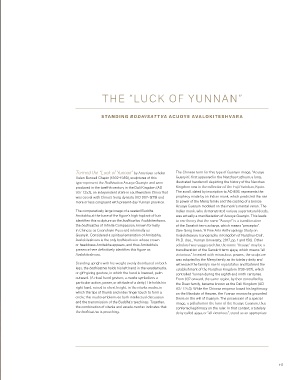Page 119 - Christie's Irving Collection Lacquer Bronse jade and Ink March 2019
P. 119
THE LUCK OF YUNNAN”
“
S TA N D I N G B O D H I S AT T VA AC U OY E AVA LO K I T ES H VA R A
Termed the “Luck of Yunnan” by American scholar The Chinese term for this type of Guanyin image, “Acuoye
Helen Burwell Chapin (1892–1950), sculptures of this Guanyin”, frst appeared in the Nanzhao tuzhuan, a long,
type represent the Bodhisattva Acuoye Guanyin and were illustrated handscroll depicting the history of the Nanzhao
produced in the twelfth century in the Dali Kingdom (AD Kingdom now in the collection of the Fujii Yurinkan, Kyoto.
937–1253), an independent state in southwestern China that The scroll, dated by inscription to AD 898, represents the
was coeval with China’s Song dynasty (AD 907–1279) and prophecy made by an Indian monk, which predicted the rise
more or less congruent with present-day Yunnan province. to power of the Meng family and the casting of a bronze
Acuoye Guanyin modeled on the monk’s mental vision. The
The comparatively large image of a seated Buddha Indian monk, who demonstrated various supernatural deeds,
Amitabha at the base of the fgure’s high topknot of hair was actually a manifestation of Acuoye Guanyin. This leads
identifes this sculpture as the bodhisattva Avalokiteshvara, to one theory that the name “Acuoye” is a transliteration
the bodhisattva of Infnite Compassion, known formally of the Sanskrit term acharya, which means “preceptor”.
in Chinese as Guanshiyin Pusa and informally as (See Gong Jiwen, ‘A Fine Arts Anthropology Study on
Guanyin. Considered a spiritual emanation of Amitabha, Avalokitesvara Iconography in Kingdom of Nanzhao-Dali’,
Avalokiteshvara is the only bodhisattva in whose crown Ph.D. diss., Yunnan University, 2017, pp. 1 and 156). Other
or headdress Amitabha appears, and thus Amitabha’s scholars have suggested that the name “Acuoye” may be a
presence here defnitively identifes this fgure as transliteration of the Sanskrit term ajaya, which means “all
Avalokiteshvara. victorious”. Invested with miraculous powers, the sculpture
was adopted by the Meng family as its tutelary deity and
Standing upright with his weight evenly distributed on both witnessed the family’s rise to royal status and fostered the
legs, the bodhisattva holds his left hand in the varadamudra, establishment of the Nanzhao Kingdom (738–937), which
or gift-giving gesture, in which the hand is lowered, palm controlled Yunnan during the eighth and ninth centuries.
outward. (A ritual hand gesture, a mudra symbolizes a From 937 onward, the same region, by then controlled by
particular action, power, or attitude of a deity.) He holds his the Duan family, became known as the Dali Kingdom (AD
right hand, raised to chest height, in the vitarka mudra, in 937–1253). While the Chinese emperor based his legitimacy
which the tips of thumb and index fnger touch to form a on the Mandate of Heaven, the Yunnan monarchs grounded
circle; this mudra emblemizes both intellectual discussion theirs on the will of Guanyin. The possession of a special
and the transmission of the Buddha’s teachings. Together, image, a palladium in the form of the Acuoye Guanyin, thus
the combination of vitarka and varada mudras indicates that conferred legitimacy on the ruler. In that context, a tutelary
the bodhisattva is preaching. deity called ajaya, or “all victorious”, stood as an appropriate
117

